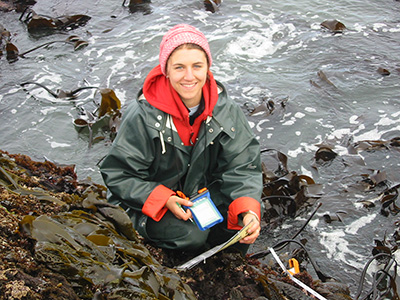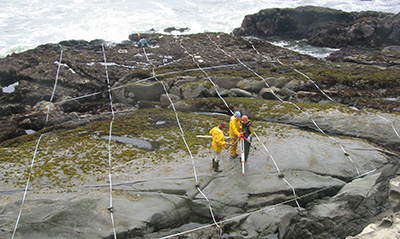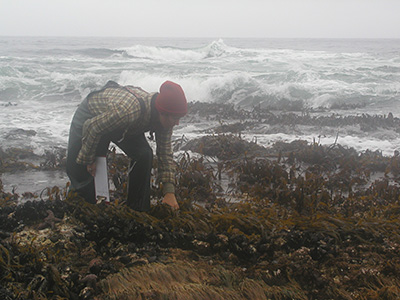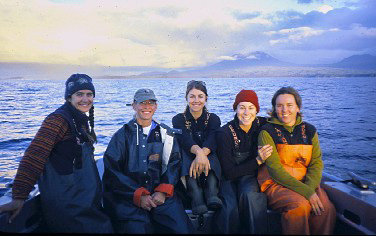Peter Raimondi, professor and chair of ecology and evolutionary biology at the University of California, Santa Cruz, has been studying marine life on the West Coast for about 20 years. But when it comes to field surveys that require identification of all the organisms that occur in a particular area, he defers to the biodiversity "SWAT team" he has assembled to conduct an unprecedented series of surveys of life on rocky shorelines along the Pacific coast of North America.
"They have become without a doubt the best team of field evaluators around. They really know their stuff," Raimondi said.
Alison Kendall, Kristen Kusic, and Haven Livingston--all graduates of UC Santa Cruz--are currently the core members of the Intertidal SWAT Team, which began doing surveys in February 2001. They have now surveyed nearly 100 sites, from Baja California to Alaska, moving in at low tide to document the abundance and diversity of algae and invertebrates throughout the intertidal zone, an area of tidepools and rocky benches between the high- and low-tide marks.
Biodiversity patterns
The findings from this massive survey project have already revealed previously unrecognized geographic patterns of biodiversity along the Pacific coast. The surveys have also resulted in major extensions of the known ranges of several species. The team's plans are to resurvey the same sites every three to five years, and in the long run these surveys will enable scientists to detect significant ecological changes that might otherwise go unnoticed.
"There have been a lot of intertidal surveys over the years in certain places, but what really sets us apart is the geographic range that we have been able to cover," Kendall said.
Raimondi had been doing surveys of intertidal life in California since 1991, with funding from the federal Minerals Management Service to establish baseline monitoring data in case of an oil spill. Eventually, he decided that a more comprehensive approach was needed to reveal broad patterns of biodiversity along the West Coast, which had never been documented using a standardized approach. He realized that this would require a group of experts who could conduct rapid, intensive surveys using standardized procedures over a large geographic range.
"The idea was to put together a team that could come in and hit a site very quickly and intensively, and then move on. That's why we called it a SWAT team," Raimondi said.
Raimondi is a principal investigator in the Partnership for Interdisciplinary Studies of Coastal Oceans (PISCO), a major collaborative project started in 1999 with funding from the David and Lucile Packard Foundation. PISCO researchers are focused on understanding the processes that drive the intertidal and subtidal ecosystems along the West Coast. Although biodiversity surveys were not initially a major focus for PISCO, the SWAT team's work is now a fundamental part of the project.
"It gives the context for almost everything else we do," Raimondi said. "What we were hoping to do was to discover broad patterns in the organization of these biological communities, and then see what causes those patterns and how they change. The surveys give us a basis from which to look for change, and they have allowed us to delineate important biogeographic regions along the coast."
Essential information
In addition, the surveys are providing essential information for the management of coastal resources, Raimondi said. "Informed management requires an understanding of biodiversity and ecological threats at a scale relevant to the system being studied. For coastal marine systems, this could mean the entire West Coast," he said.
As word has spread about the Intertidal SWAT Team's expertise and growing database of information, requests for samples and data have begun pouring in from outside scientists. "A lot of people just want to pick our brains about species distributions, because we travel so much. We have in our heads a lot of information about where you can find different species and general trends that would be hard to find in textbooks or journals," Livingston said.
The typical survey site is a gently sloping, rocky intertidal bench. The survey protocol is the same at every site and begins with laying out a giant grid that extends at least 30 meters along the shore and as far out as the tide goes. Team members record the species present at 100 locations along each of 11 transect lines running down the bench toward the ocean. At three spots along each transect, they lay down a large square of PVC pipe and record all the mobile invertebrates, such as snails, limpets, and crabs, within the square. They also map the locations of all sea stars (important predators in the intertidal zone) along each transect.
Team members move quickly, recording data on Palm Pilots equipped with bar-code readers so that common organisms can be recorded by simply scanning a bar code on a laminated data sheet. At the end of the day, all of the data are downloaded onto a laptop computer.
On the first visit to a site, the team drills bolts into the rocks to help them relocate the same site for repeat surveys in subsequent years. The team also creates a detailed topographic map of each site using surveying equipment and 3-dimensional computer graphics. "Then we can overlay the species we've recorded onto the topographic map, so you get a picture of how small changes in elevation can affect which species are present," Livingston said.
The team is often accompanied by other members of Raimondi's lab, other PISCO researchers, volunteer helpers, and local experts. Two key contributors to the SWAT team's work are David Lohse, a postdoctoral researcher in Raimondi's lab, and Carol Blanchette, a PISCO scientific coordinator based at UC Santa Barbara. Lohse works closely with the SWAT team and helps out at many of the survey sites. Blanchette helps in the field and with data management and analysis.
Kendall and Kusic, who both have bachelor's degrees in marine biology, were among the four original members of the SWAT team. Livingston, who has degrees in environmental studies and water resource management, joined a year later.
"I can identify hundreds of species now, but it took a lot of training. The learning curve is really steep, even for those who come in with a degree in marine biology," Livingston said.
Taxonomic workshops
Team members regularly attend taxonomic workshops to hone their identification skills, and Kusic recalls taking furious notes at the workshops during her first year on the job. One year later, however, she and other team members were leading some of those same workshops.
Whenever the team goes to a new survey site, members contact regional experts and, if possible, bring them along to help with species identifications. But there are few intertidal experts who have seen as much of the West Coast as the SWAT team.
"We get to go to a lot of great places, including some remote places that most people don't have access to," Kusic said. "And we get to work with the local experts and rangers who really know the area and are willing to share their knowledge with us."
"It's a dream job, being outdoors and working in these amazing places," Kendall added.
The SWAT team spends a lot of time on the road, moving from site to site. The surveys have taken them to the Gulf of California, the Channel Islands, and Glacier Bay, Alaska. All of the team members enjoy the work and love being outdoors, but by the end of the field season they are ready to spend some time at home, Kusic said. From midsummer into fall, the minus tides tend to occur at night, and during this period the team keeps busy at UCSC's Long Marine Laboratory, sorting specimens and organizing their data.
"Voucher" specimens are collected to document the species identified during the surveys. The team's algal specimens are now stored at UC Berkeley's Jepson Herbarium, while the invertebrate specimens will be housed at the California Academy of Sciences in San Francisco. "All the taxonomists we worked with told us that no one would believe our results if we didn't have voucher specimens," Kendall said.
Several members of the SWAT team have recently moved on to other things. Erin Maloney, one of the original members, left a few months ago to run an invasive species program at Moss Landing Marine Laboratories. Megan Williams, also an original member, spent the past year studying science writing at UCSC and will soon be on her way to New York to work for Discover magazine. Caroline Engel, who has been with the team for about a year, will be working part-time in a PISCO research lab. Kendall took last year off to study science illustration at UCSC and is only back with the team temporarily.
The fact that all of the SWAT team members so far have been women was not by design, although it does make sharing tents and motel rooms a bit easier, Livingston said. "But we're a nonexclusive club," she said.
People often ask them what SWAT stands for. Officially, they say, it doesn't stand for anything, but unofficial suggestions from team members abound, including Soaking Wet and Tired; Stinky, Wrinkled and Tough; SeaWeed Action Team; and Scientific Women at the Tides.
Primary funding for the intertidal SWAT team's coastal biodiversity survey is from the David and Lucile Packard Foundation through the PISCO project and from the Minerals Management Service, a bureau of the U.S. Department of the Interior. More information about the survey is available on the team's web site at http://cbsurveys.ucsc.edu.
PISCO is a long-term, interdisciplinary program that includes research and monitoring of not only the intertidal zone, but also the nearshore rocky reefs and kelp beds along more than 1,200 miles of coastline in California and Oregon. Started in 1999 with a five-year, $20 million grant from the Packard Foundation, PISCO is led by researchers at UC Santa Cruz, UC Santa Barbara, Stanford University's Hopkins Marine Station, and Oregon State University. The Packard Foundation has provided an additional $4 million grant this year to support PISCO's ongoing work.






